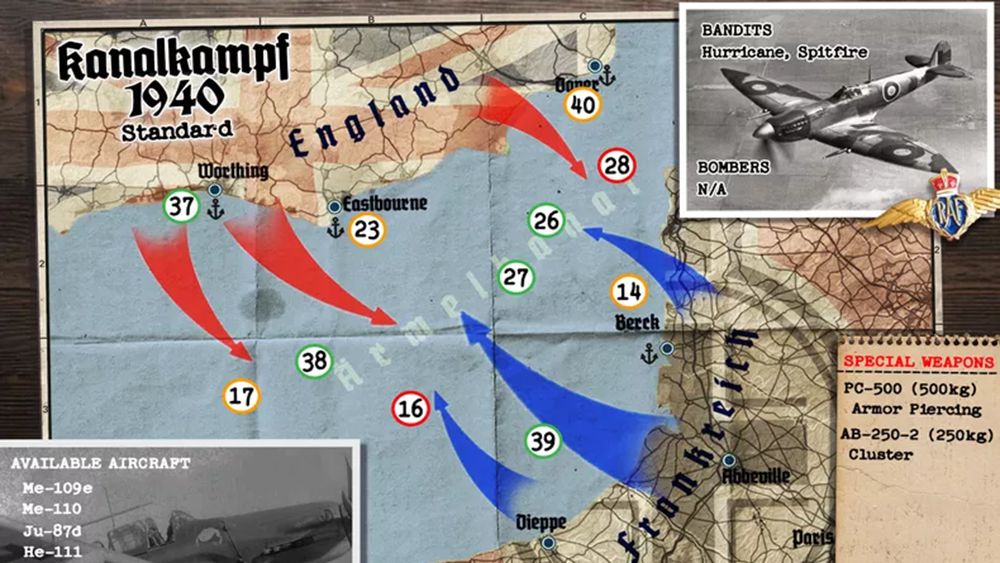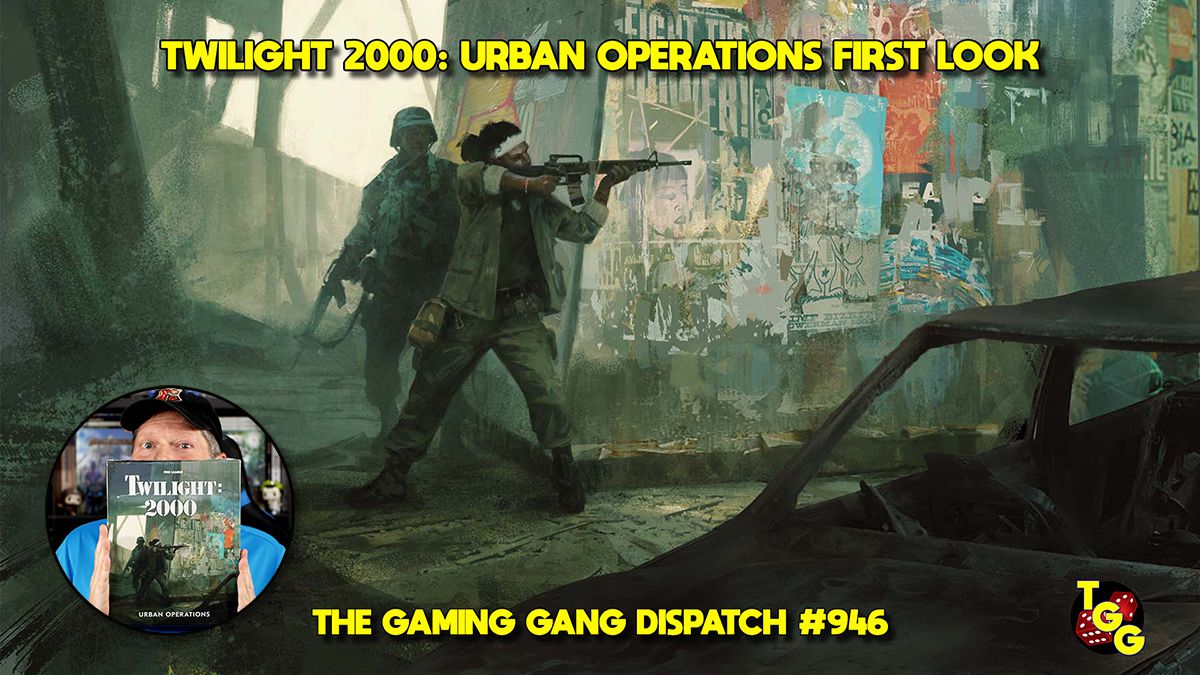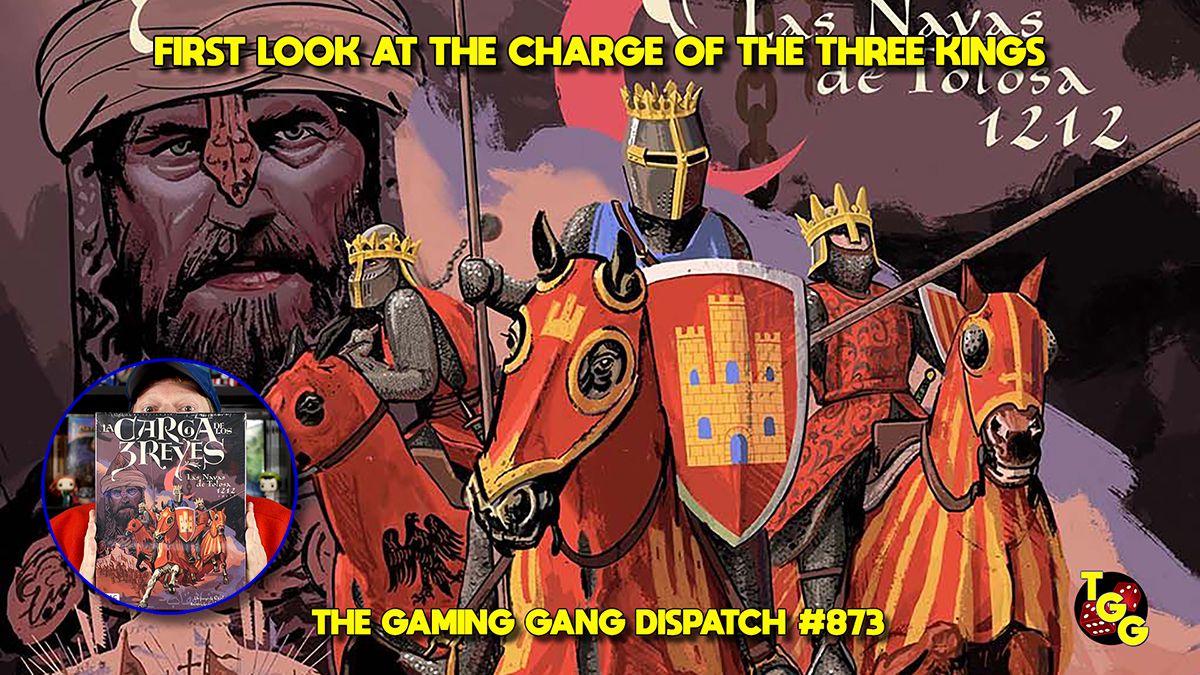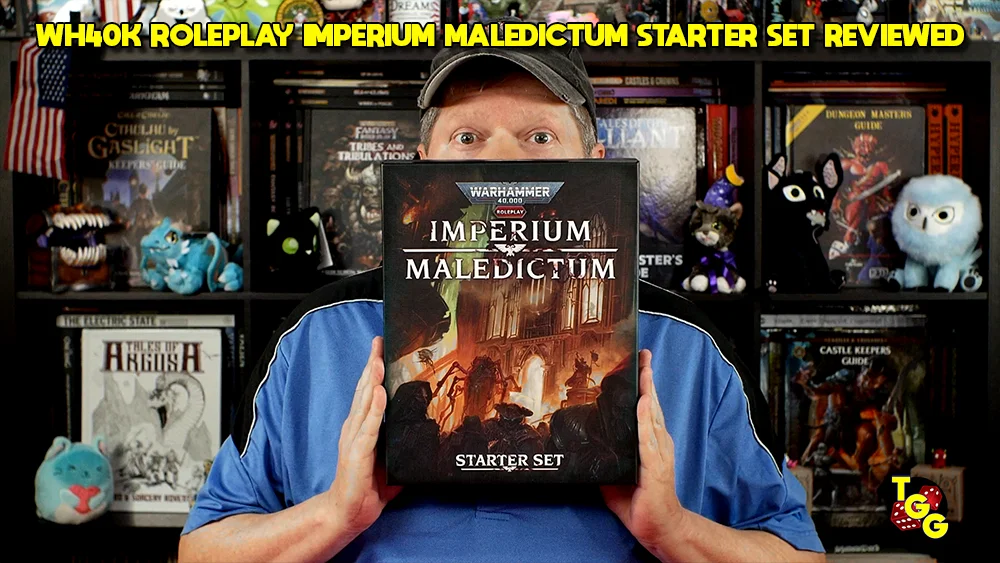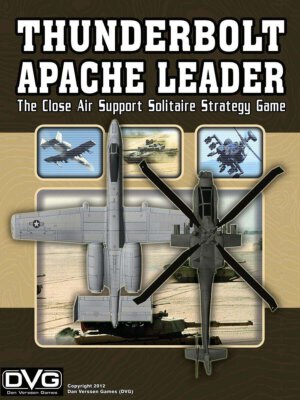
Publisher: Dan Verssen Games
Designer: Dan Verssen
Year: 2012
Players: Solitaire
Ages: 12+
Playing Time: 40-60 Minutes per mission
Genre: Solitaire modern era air command wargame
Retail Price: $89.99
Thunderbolt-Apache Leader is the latest in the “Leader” series from Dan Verssen Games and if you’ve played any of the previous titles (such as Hornet Leader, Phantom Leader, or even U-Boat Leader) quite a few mechanics will be familiar but, for the most part, there’s a lot new and different in Thunderbolt-Apache Leader (TAL) to make it a whole new ballgame. And by this I can say if previous Leader games were in the line of kicking it with your friends at the ballpark watching your favorite team then Thunderbolt-Apache Leader is on the level of having first row tickets behind your favorite team’s dugout for game seven of the World Series.
Or, in other words, TAL is the definitive air based Leader game!
Upon opening the box you’ll find everything is top notch quality throughout. Counters, cards, terrain tiles, the mounted tactical map and play aid, as well as the rule book are excellent. If there could be any complaints I would say the side aid chart could have been mounted and there’s only one pilot log that you’ll need to photocopy but that’s really nitpicking as all that’s included really is outstanding all in all.
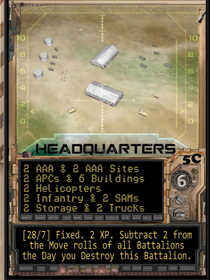
Your role in TAL is that of the overall commander in charge of the pilots and aircraft of a squadron of U.S. Close Air Support (CAS). Within the campaign you’ll have to manage your aircraft and pilots, weapon load outs, mission selections, refits and repairs, and more. You’ll have a lot on your plate but this is part of the great appeal of the game as every decision you’ll make could (and more than likely will) effect how well your squadron performs throughout the campaign.
You’ll begin each game by selecting from one of the eight included campaigns. The Campaign card provides information regarding the difficulty level of the campaign, the varying determinations of success or failure, terrain tiles to by utilized, and the victory points worth of enemy battalions you’ll be targeting for destruction. Along with this you also determine what the Situation may be for that campaign. Are you fighting a holding action? Is this more of a show of force? Or has your airbase been cut off from their line of supply and you need to battle your way out to reclaiming that vital lifeline? These Situations also show how long the campaign will last and may even include bonuses for your initial fighting force. I find the Situations a great addition as they bring even more replayablity to a game already packed with options.
It’s important to note that just as in other Leader titles, the currency available to you to purchase aircraft, pilots, make repairs, activate special bonuses and so forth are the Special Operations (SO) points. The Situation card will show you how many SOs you begin with and how many (if any) you’ll receive each day. Each situation also brings with it certain specific conditions that are in effect for the campaign. When, how, and where to spend – or possibly save – precious SOs is crucial to success in any given scenario; you will fail miserably if you don’t manage your SOs well. You’ll soon learn to squeeze every ounce of value from your SOs as they are few and far between.
Once you’ve selected the campaign and determined the Situation you’ll have one more card to draw and that is the Special Condition. You’ll draw one of these at the beginning of each campaign day and the results could be beneficial to yourself or the enemy. You may even be forced to spend SO to prevent something bad from taking place. Oh, the mistress of war, she be a fickle wench!
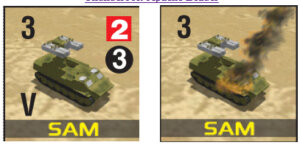
Now you have the overall strategic situation in front of you and can begin planning how you’ll begin to rain destruction from on high.
Pilots to Your Aircraft
So far the decision making has been mostly out of your hands as you’ve been drawing randomly for your enemies and Special Condition setup. Now comes the opportunity to begin to assemble your squadron with which you hope to decimate the enemy in force. Although nine aircraft are modeled in TAL you probably won’t have all of them to choose from depending on the time period the campaign takes place. You’ll begin spending those SOs as you weigh the capabilities of each aircraft with the forces arrayed against you before you begin to make purchases. It is tremendously important to take a good look at the sorts of units you’ll be engaging (they’re located on the battalion cards) as there’s nothing worse than getting over the target only to find you’ve brought a knife to a gunfight…
For the most part you won’t be able to put together a squadron of the newest and shiniest aircraft since most successful campaigns will require you to destroy (at minimum) a couple battalions a day and to fly enough missions to do so requires pilots, aircraft, and ordinance. Sure that A-10C is a sweet death dealer but for the same cost you can snag up to three helicopters. In your first campaign you’ll be tempted to load up on the hottest aircraft and if you go that route you’ll scratch your head when the end tally comes about and you finish up with a dismal rating. Knowing you’ll have to fly multiple missions in a single day, and these are the aircraft you’ll utilize throughout, it’s a good idea to try to balance aircraft capabilities with numbers as you’ll need to continually divide your squadron in order to attain victory. Each aircraft card will indicate what their cannon attack is along with how many structural hits it may take before being destroyed, the weapons it may carry, the weight of ordinance it can carry, as well as any additional notes or modifiers associated with the aircraft.
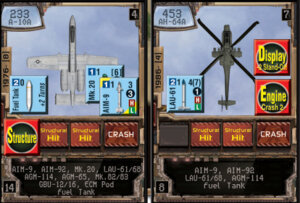
You can select one average skill pilot for each of you aircraft as well as one additional pilot for each type of manned aircraft you have in your squadron. Once you’ve selected your pilots you may adjust their experience level on a one for one basis. For example if you’d like to bump one pilot up a level you need to drop another pilot one level in return. You also have to opportunity to spend SOs to increase the experience of a pilot but understanding those SOs are hard to come by you may want to fight the urge.
Once you have your aircraft and pilots you’ll put together the load outs. There’s lots of ordinance to choose from and each is represented by a counter. Air-to-air missiles, rocket pods, Mavericks and Hellfires, bombs of all sorts (smart, dumb, and cluster), fuel tanks and electronic countermeasures pods are all modeled. All but the weakest come at a price and even the freebies weigh something so not only cost but weight comes into play. You’ll receive ten points to spend on ordinance for every one SO you invest and you’ll be loading your aircraft to the limits of their capabilities. It’s also important to remember the further away your target battalion is will reduce the amount of weight your aircraft can carry.
All that’s left now is to decide if you’d like to invest SOs on Scouts as these can be invaluable before the mission begins. A Scout costs one SO but can gain you additional time over your targets or provide other bonuses so, if you have the SO to spare, I normally recommend using them. Scouts may only be used for one mission per day but they can provide a lot of advantages.
You’re now locked and loaded so you’ll simply designate what aircraft are attacking what battalions and then it’s time to scream into action.
Over Target and Prepared to Engage
You’ll begin each mission by drawing a Mission Event card and this indicates something that takes place during the target bound portion of the mission. You may have the chance to spend an SO to gain an advantage or possibly lay a hurt on the enemy before arrival while other times this may be something bad happening to your aircraft. Once you’ve played the Mission Event you’ll take the ten terrain tiles indicated by the campaign card and randomly place them on the board in three rows consisting of three on top, four in the middle, and three on the bottom. This shows you the battlefield you’re approaching. The tiles may indicate ridge lines along the battlefield and these come into play by blocking line of sight for low flying aircraft as well as adding pilot stress to anyone flying low over them. Ridges also can provide cover for the enemy. Then you’ll select the target units as indicated by the Battalion card and roll the included D10 for each in order to randomly place them on the tiles. One represents the upper top tile while a ten is the lower right tile.
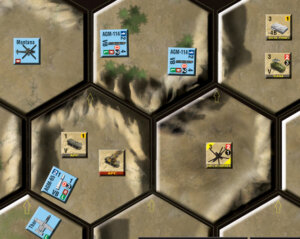
Each turn you’ll begin by drawing one Pop Up counter for each aircraft flying at high altitude. This is done during each aircraft’s turn so Pop Ups are drawn at different times. This counter could result in either a no enemy result (keep your fingers crossed for those) or an enemy unit. If it’s a unit you’ll roll randomly and place this newly discovered enemy on the appropriate tile. These units can be a real thorn in your side because eliminating them doesn’t count toward your victory points required to destroy the Battalion and are yet another incoming attack you need to contend with. Thankfully, Spectres and unmanned Predators don’t draw Pop Up counters.
Next you roll to see if the enemy begins to take cover. What? You thought these guys were just going to wait out in the open like sitting ducks? You’ll consult the chart to see what units move to available cover (ridges for example) and those that do are moved into the appropriate hex terrain to show they are now in cover. Enemies in cover can only be attacked close up in the same hex so your Stand Off weapons are now useless against them. There’s nothing worse than flying into an area with aircraft loaded for bear only to have the bear scurry into his cave and shut the door… Once again it’s that knife at a gunfight situation. If you’re lucky and roll a ten, you’ll force some defenders out of cover.
During the combat phase, Fast pilots are able to move and attack first. Before any of your aircraft move and/or attack you have to determine their altitude. Once Fast pilots have completed their turn, the enemy makes their attacks followed by your Slow pilots taking their turns.

When you attack you have plenty of options as you may do so before, during, or after movement. Each aircraft may also make as many attacks as it has available targets so you can be firing off an air-to-air missile while dropping cluster bombs and the like. The only exception to this is cannon attacks as these can be the only attack made during the turn if chosen. Newer aircraft also tend to have the capability to be “linked” which allows the sharing of targets and usually eliminates line of sight as any aircraft linked to another with a target in sight may also attack that target if it’s in range. Missions utilizing Predator drones also allow for linking.
Determining your attacks couldn’t be easier; each weapon has a number and to hit you need to roll that number or higher on the D10. If you hit, the target is toast so there are no worries about damage reduction or tracking damage to the enemy. Some weapons attack everything in a hex so there’s loads of devastation which can be brought to bear. Depending on the weapon in question (and the aircraft altitude) you’ll either be able to attack units in the same hex or make ranged attacks. There are also weapons which are designated as being unusable in the same hex as the aircraft as well. Obviously there are modifiers to your die roll which come into play for a variety of situations such as type of target, pilot skill, aircraft damage, and so forth.
But were getting a little ahead of ourselves because outside of those Fast pilots, the enemy is going to attack before any of your other aircraft and early in a campaign you’ll probably only have Slow pilots. Enemy helicopters which can trace a line of sight (they’re always considered low altitude) to one of your aircraft will move one hex closer to it and attack. All other enemy units will attack anything in range and outside of AA, helicopters, and surface-to-air missile launchers most can only attack into the same hex. Enemies who can attack at range will have the number of hexes they can reach printed on the counter.
Your enemy doesn’t roll to hit but each unit counter indicates how many and of what color damage counters are randomly drawn if you have aircraft in range under attack. These counters have two sides; one with a yellow damage indicator (light) or red (heavy). Pilots with the Evasive skill can negate one light damage or downgrade one heavy damage to light for each point they have in the skill. Aircraft with electronic counter measures (ECM) pods can also roll to avoid hits.
Damage counters may show no damage at all or indicate hits to various systems, structural damage, negative modifiers, or even a pilot kill. Each aircraft has a number of structural hits it can take before it is downed. Interestingly enough some of the damage counters show a type of aircraft and if that happens to be the aircraft taking damage then the counter is ignored. This simulates the ability of say the A-10, Apache, and F-16 to handle a lot of punishment before they’re knocked out of action. Unmanned aircraft may also be attacked by the enemy as well.
Once all enemy attacks are resolved, pilots who are Slow select altitude, draw Pop Ups, and continue along with their turns. Once all of this is done the Loiter counter moves down one space and the entire process begins again with the actions of Fast pilots. As time begins to run out you’ll begin to direct your aircraft toward the edges of the battlefield as you don’t want to find yourself looking at your aircraft sitting on Bingo Fuel. As the battle progresses you’ll need to keep a sharp eye on where you’ve been moving your slowest units (such as helicopters) because you want them everything off board when the clock runs out. If not, you have to roll on the Bingo Fuel chart to see if each aircraft low on fuel makes it back to base. stay too long and the aircraft automatically crashes. There’s nothing worse than losing an pilot and/or aircraft simply because you weren’t paying attention in the midst of the fight.
After all aircraft have vacated the battlefield you’ll count up the point value of all enemy units remaining in the fight (not counting those Pop Up units as they have no value) and consult the Battalion card. If the point value is equal to or less than the first number shown the battalion is reduced to half strength and the corresponding counter on the area map is flipped to its half strength side. If you manage to have equal to or fewer than the second number shown then you remove the battalion counter completely as you’ve knocked the hell out of them, they no longer pose a threat and are considered destroyed.
Once the mission is winding down you, and your aircraft at heading back to base, draw another Mission Event card and follow the instructions in the Home-Bound section. Just as during the target bound flight, this could be something good or something bad…
After you’ve completed the mission you’ll calculate pilot Stress gained during the mission minus whatever Cool rating the pilot has, award experience points to all pilots who took part in the mission (in longer campaigns you can see your pilots improve), record damage to the aircraft, and chalk up the victory points for that mission. If you have any other missions scheduled for the day you’ll begin once again with those units starting with drawing a Mission Event for that group as they head off to their target battalion.

Then it’s time to congratulate yourself on a job well done and hit the sack because the next day of the campaign is right around the corner. Whenever the campaign ends, either because you’ve completed the requisite number of days or you were unable to pay an SO penalty, you’ll total up the victory points you’ve earned by destroying or reducing enemy battalions and consult the campaign card to see how successful (anywhere from dismal to great) your command has been.
The Verdict
I’ll have to say in describing TAL I probably haven’t done the game the justice it truly deserves. Even though it may seem as if the complexity level would be fairly high for all that’s going on you’d be amazed at how easy the game is to get up and running. Once you’ve had a read through of the rules and get your first campaign started, it’s highly doubtful you’ll refer to the rules more than once or twice during a session of play and that will probably be just to check what you can do at the end of the day. Almost everything you need to consult is right in front of you on the table at any time during a mission. Counters show relevant information while cards and the boards have all the required charts there at a glance.
Regulars to TGG know I’m not one to engage in hyperbole so when I say Thunderbolt-Apache Leader is one of the best games I’ve played it would be in your best interests to take heed. Keep in mind I didn’t say best solitaire game… I said game.
At every turn you’re confronted with meaningful decisions throughout play; beginning with the selection of pilots and aircraft to the in mission choices, up to the end of the campaign day where you have to juggle your resources in an attempt to stretch them even thinner, as you look to keep your aircraft and pilots combat ready. As each mission come to completion (sometimes with less than the desired results) you’ll find an ever growing narrative of the exploits of your squadron and pat yourself on the back for solid choices made while kicking yourself for botching something which should have been obvious or making some bad die rolls. All in all, regardless of success or failure, TAL will have you coming back to get one more mission in or tackle just one more day of a campaign.
The price tag may deter some but the amount of gameplay and the number of options which give TAL tons of replayablity could lead some gamers to leave the game set up in some corner of the house so they can pick it up and spend thirty to forty-five minutes flying a sortie whenever the desire strikes. For both die hard grognards and new comers looking for an accessible entry into the wargame genre I can’t recommend Thunderbolt-Apache Leader enough!
[rwp-review id=”0″]
- Space 1999: The Roleplaying Game Receives a Free Quickstart - Apr 4, 2025
- PWYW for the Temple of the Beggar-King Adventure for OSE Advanced Fantasy - Apr 4, 2025
- Score Savings with the Feng Shui Ammo Pack - Apr 4, 2025



